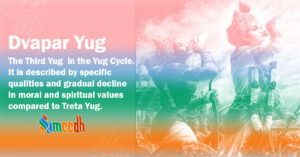Dvapar Yug is the third of the four Yugas or ages in Hindu cosmology, following Satya Yug and Treta Yug and preceding Kali Yug. Even before the beginning of Dvapar Yug, by the end of Treta Yug, human beings began to stray from the path of dharm, or the religious way of life.

Dvapar Yug is marked by a further decrease in righteousness and an increase in unrighteousness. Each Yug is characterized by specific qualities and a gradual decline in moral and spiritual values. In every yug cycle, or chaturyug, there are ten prominent avatars known as the Dashavatar. Of these, two appear in Dvapar Yug: Krushna and Balaram (or Buddha). There is also another important avatar known as Vedavyas.
Here are some significant stories and themes associated with Dvapar Yug:
- Mahabharata:
- Background: The Mahabharat, one of the two major Sanskrit epics of ancient India, is a central narrative associated with Dvapar Yug.
- Key Characters: The epic revolves around the conflict between two branches of the Kuru dynasty, the Pandavs, and the Kauravs. Notable characters include Yudhishthir, Bhim, Arjun, Nakul, Sahadev, Duryodhan, and Karn.
- Bhagavad Gita: The Bhagavad Gita, a sacred scripture within the Mahabharat, is a dialogue between Prince Arjun and Lord Krushna, who serves as his charioteer. The teachings in the Gita cover various aspects of duty, righteousness, and the path to spiritual realization.
- Lord Krushna’s Life:
- Birth: Lord Krushna, the eighth avatar of Lord Vishnu, is believed to have been born in Dvapar Yug. His birth is celebrated as Krushna Janmashtami.
- Childhood Exploits: Krushna’s childhood is filled with divine pastimes, including his playful activities, miracles (leelas), and his role in protecting the residents of Vrindavan from various demons.
- Rukmini-Harana (Kidnapping of Rukmini):
- Lord Krushna’s marriage to Rukmini is a significant event during Dvapar Yug. Krushna kidnapped Rukmini, who was to be married to Shishupala against her will. This event symbolizes divine love and the pursuit of dharm.
- End of Dvapar Yug:
- The Dvapar Yug concludes with the Mahabharat war, which leads to the destruction of many Kshatriya warriors and the eventual departure of Lord Krushna from the earthly realm.
Significance of Dvapar Yug:
- Decline in Virtue: Dvapar Yug is characterized by a decrease in virtue and an increase in unrighteousness. The moral and spiritual decline continues from the previous ages.
- Introduction of Rituals and Ceremonies: As righteousness diminishes, formal rituals and ceremonies become more prominent as people seek ways to maintain spiritual connection and observe dharm.
- Religious Practices and Devotion: Dvapar Yug witnesses a shift toward more elaborate religious practices and devotional worship. Temples and rituals become more intricate during this age.
- Preparation for the Advent of Kali Yug: Dvapar Yug sets the stage for the advent of Kali Yug, the final and most tumultuous age in the Yug cycle.
The stories and events associated with Dvapar Yug, particularly those in the Mahabharat and the life of Lord Krushna, provide profound insights into the complexities of human nature, the challenges of maintaining dharm, and the divine interventions to restore cosmic order.